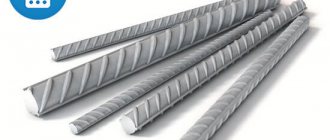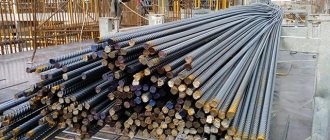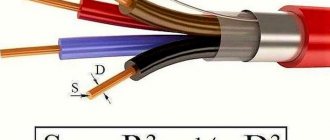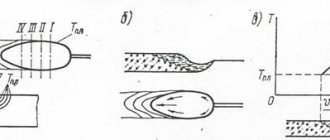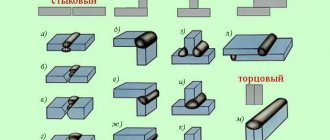If there is no possibility of direct weighing, the weight of scrap metal can be determined in other ways. The most accurate result will be given by calculation, but other possibilities should not be neglected.
So, in order not to burden readers with unnecessary formulas, which will still be there, but below, we will immediately designate the formulas for calculating the most popular products from rolled steel and pipes - rolled pipes. Here you will not find an online calculator for calculating weight, only formulas that you remember once you no longer have to use special calculators. For example, when dismantling metal structures or a chimney, you don’t always have a computer, the Internet or a reference book at hand, but the structures are all welded from rolled steel here and our formulas will help out!
Formula to calculate pipe weight
M=(Ds)*s*0.02466
, Where
- M— weight of one linear meter of pipe, kg;
- D is the outer diameter of the pipe being calculated, mm;
- s—pipe wall thickness, mm;
- 0,02466 —coefficient for steel density equal to 7.850 g/cm3.
This formula is very accurate. You can calculate the weight of the pipe and compare the calculated weight with the theoretical one in any range and the value according to the formula will be more accurate! You can also calculate
Calculation of weight using mathematical formulas
The weight of any product is found as follows: M = ρV ( ρ – density, V – volume of the product) or by the mass formula through the cross-sectional area: M = ρSL ( S – cross-sectional area, L – length). For carbon steel, it is customary to use an average value of ρ equal to 7850 kg/m3 or 0.00785 g/mm3, or 7.85 g/cm3 (depending on the selected units of measurement). The simplest calculation is the mass of a steel cube with a side of 1 m. It is equal to 7850 kg, or 7.85 tons.
There are practical and theoretical formulas for mass. The former are adapted to certain conditions in order to facilitate and speed up calculations.
Sheet metal
To calculate the weight of sheet metal, you need to multiply 3 dimensions - the length, width and thickness of the product, and multiply the resulting result by the density of the metal. For example: rolled length is 1 m, width is 2 m, thickness is 2 mm, then M = 1 × 2 × 0.002 × 7850 = 31.4 (kg).
When determining the mass of several identical sheets of iron, it is enough to calculate the weight of 1 sheet and multiply by the quantity.
Rod, wire and fittings
To determine the mass of a rod or any product of round cross-section, the following theoretical formula is used: M= πR2Lρ , where L is the length, R is the radius of the workpiece, π = 3.14, ρ is the density of the metal. Another practical formula: M = (0.02466R2)L . It can also be used for corrugated fittings.
Finding the mass of a rectangular rod from the volume is quite simple. You need to multiply the length, width and thickness (this is the volume V ), then find the corresponding density in the reference book and multiply it by V: M = ABLρ , where A, B are the width and thickness.
Circle
To find the weight of a metal circle, you need to substitute the numerical values into the formula: M = πR2dρ ( R – radius, d – thickness).
Hexagonal rod
It is best to turn to ready-made tables for help, but in their absence, you can do the calculations yourself:
M = (3√3/2)а2Lρ,
where a is the length of the hexagon side (mm), L is the length of the rod (mm), ρ = 0.00785 g/mm3.
Rectangular profile
You can find out the mass of a rectangular profile pipe as follows:
M = 2(a+b)sLρ,
where a and b are the width and height of the section (mm), s is the wall thickness (mm), L is the length of the pipe (mm), ρ = 0.00785 g/mm3. If the walls are of different thicknesses, several measurements are taken and the average value is found.
Weight of round pipe
The weight of the pipe is calculated using the following formulas:
M = π(R2 – r2)Lρ, M = 2πRsLρ, M = (Ds)s×0.2466
where M is mass, R2 is outer radius, r2 is inner radius, L is pipe length, ρ. – steel density, s – wall thickness, 0.2466 – constant corresponding to the density of carbon steel ρ = 7.85 g/cm3.
A pipe with a closed end can be considered as a barrel and the formulas presented above for a pipe and a circle can be used to find its weight.
Weight of figured products
It is possible to calculate the mass, knowing the volume and density, for products of any configuration. You just need to correctly calculate the volume and substitute the value into the well-known formula M = Vρ .
The volume of the pyramid is calculated by the formula: V = 1/3 SH , where S is the base area, H is the height of the pyramid.
For a truncated pyramid, V = 1/3 h(F + f + √Ff) , where F and f are the areas of the larger and smaller base.
Cylinder volume: V = πR2H.
Volume of a cone: V = 1/3 πR2H , volume of a truncated cone: V = 1/3 πH(R2 + Rr + r2) , where H is the height, R and r are the radii of the larger and smaller base.
Sphere volume: V = πD3/6 ( D – diameter).
For a corner: V = s(h1 + h2)L , where L is the length of the corner, s is the thickness of the metal, h1 and h2 are the width of the shelves.
The volume of a product with an ornate shape and small dimensions is determined by the amount of displaced liquid by placing it in a container of water.
If a structure is made of different metals and alloys, then its mass can be found through the weight of individual parts.
Theoretical weight is calculated using formulas, practical (actual) is determined by weighing. Naturally, there will always be a discrepancy between these values. Calculation of the mass of the workpiece, made independently using mathematical formulas, may also differ from the tabular ones or those given by the calculator.
To obtain more accurate results, it is advisable to use data from reference books or electronic computing devices.
Calculating the weight of a sheet of metal
M=S*7.85
, Where
- M—mass of steel sheet, kg;
- S is the area of the calculated sheet, in square meters;
- 7.85 - weight of a sheet 1 mm thick and 1 square meter in area, in kilograms
This way you can calculate the weight of a sheet of metal of any size, for which you can calculate the area. The accuracy of calculations using this formula is higher than the theoretical mass in reference books, because in the assortment, when calculating the mass of metal, the program rounds the values. Well, how to find out the area of a sheet (of any shape - square, rectangle, parallelepiped, trapezoid, rhombus, etc.) - every person who has graduated from high school should know.
How to calculate the weight of reinforcement and rod
For a circle, rod, smooth reinforcement, the formula for calculating the mass will be as follows:
M=(0.02466*D2)/4
, Where
- M—weight of 1 linear meter of circle/reinforcement/rod, kg;
- D—circle diameter;
- 0,02466 —coefficient for steel density equal to 7.850 g/cm3
To calculate the weight of corrugated reinforcement (A2, A3), you can and should use the same formula! There will be no discrepancies with the theoretical mass, despite the different cross-sectional designs.
It is, of course, impossible to calculate such a pile of scrap metal using formulas without weighing
Main characteristics of the steel circle
Rolled steel with a round cross-section is made from “black” unalloyed steels, low-alloy, corrosion-resistant, heat-resistant and heat-resistant. Their density depends on the specific brand and is in the range of 7700-7900 kg/m3.
In regulatory documentation and reference books, to calculate the mass of 1 linear meter of steel circle, the average steel density is used - 7.85 kg/dm 3. More accurate calculations are carried out using online calculators, which use exact densities of the main steel grades for calculations.
The range of hot-rolled wheels is determined by GOST 2590-2006. In accordance with this standard, hot-rolled round steel is produced in the diameter range - 5-270 mm. Circles with diameters of 270-300 mm are manufactured only according to individual orders. Cold-rolled products are produced in accordance with GOST 7417-77, diameter range - 3-100 mm.
General approaches or a little boring theory
To determine the weight of any object, simply multiply its volume by its specific gravity. If everything is more or less clear with specific gravity, then volume is more difficult to determine (if you do not consider such simple shapes as a cube). The most general principle for calculating volume is Gulden's principle, when the cross-sectional area of an object is multiplied by its height. There are also usually no problems with the height of the metal structure; it is easy (or almost easy) to measure directly, especially if the height section is constant. This can be done for steel pipes of any section and profile, I-beams, channels, angles, etc. We will consider the method for determining the mass of metal objects of complex and variable shapes later.
Calculation of the weight of a steel circle
Correct calculation of the weight of a steel circle
ensures that all stresses associated with the use of such material are taken into account. But it is used quite widely. This includes construction (construction of balconies, for example), and repairs aimed at improving the characteristics of existing structures.
The steel circle is also suitable for solving a wide variety of interior tasks. Naturally, in itself it is not a decorative element. However, it can be used as a basis for fairly complex designs.
What does calculating the weight of a steel circle give?
Various steel products have found application in various sectors of life and production in particular. Railcar or automotive manufacturing cannot do without such parts. However, like machine tool building.
But you can’t just start using a part. It is necessary to take into account what effect it will have on the entire structure, how much it will weigh it down. The steel circle can put noticeable pressure on the base. To avoid deformation, it is necessary to make the correct calculations and select all the elements so that the structure does not ultimately fall apart.
In a word, engineers and designers simply cannot do without such calculations. Moreover, they are important both in theoretical terms and in purely practical ones. Even if a specialist is currently only working on a project, he needs to justify his calculations. And to do this without calculations is, to put it mildly, difficult.
What other construction calculators will help us?
Calculations in the field of construction or design of something are carried out constantly. In fact, this is one of the main processes. And it’s not surprising: if you don’t take pressure into account and don’t distribute the load evenly, the structure will turn out to be unviable. It is errors in calculations that lead to the fact that today many residential complexes begin to fall apart just a couple of years after commissioning.
So if you need to calculate the weight of a steel bend, we are at your service. Moreover, obtaining accurate data with us is quite easy and will not take much time.
We can also calculate the weight of the steel strip. Like other products made from this material, it is used to strengthen various structures. However, it is also very useful as a separating element.
How to calculate the weight of a steel circle?
So, you need to know the weight of the steel circle. First, choose what exactly you will calculate. If this is still weight, then the next step is to decide on the grade of steel. This point is important because it directly affects weight.
Next is the diameter of the circle and the length. If you don't know where to get the data, look at the invoices. There must be accurate information there.
Then all you have to do is indicate the quantity and determine the accuracy.
But you can skip the “cost” column. If you leave 0 in this field, the calculator simply will not calculate the cost for you. But if you add specific numbers, you will find out how much you will have to pay for the amount of rolled metal you need. An important point: our calculators run without problems on PCs, laptops, smartphones and tablets. So if you are involved in construction or renovation, just bookmark this page. We are sure that you will still need it!
Volume of a truncated pyramid
The enclosing caps, protective latches and doors have the shape of a truncated pyramid. In such situations, a dependency is used:
, Where:
- h – height of the truncated pyramid;
- F is the area of its larger base;
- f is the area of the smaller base.
If the pyramidal part of the structure sold for scrap is somewhat deformed, then the missing volume is added or removed from each side.
Volume of wedge and obelisk
The wedge in the technique is often a pentahedron, the base of which is a rectangle, and the side faces are isosceles triangles or trapezoids. The formula for calculating the volume of a wedge is:
, Where:
- a – side of the base of the wedge foot;
- а1 – width of the wedge top;
- b – wedge thickness;
- h is the height of the wedge.
An obelisk is a hexagon, the base of which is rectangles located in parallel planes. The opposite faces are symmetrically inclined to the base of the obelisk. Volume of this geometric body:
, Where:
- a and b – dimensions of the length and width of the larger base of the obelisk;
- and a1 and b1 – the smaller base of the obelisk;
- h – height of the obelisk.
Volumes of rolled profiles
Most often it is necessary to determine the weight of tees, I-beams, channels, and angles. The following dependencies are used for this:
For the brand
,where b and b1 are the width of the shelf and wall of the tee, respectively; h and h1 – thickness of the base and flange of the tee; H – height of the T-bar fragment;
For I-beam
,where H is the height/length of the I-beam; a – I-beam wall thickness; с and с1 – thickness of the I-beam flange at the base and at the end, respectively;
For the corner
,where H is the length of the corner; l1 – angle thickness; h1 and h2, respectively, are the width of each shelf.
Determination of the mass of a batch of rolled steel round section
The standard length of round rods depends on the grade of steel used to manufacture the product. The following standards have been established for hot-rolled metal products:
- rolled products from “black” unalloyed grades of ordinary quality and low-carbon steel – 2-12 m;
- metal products made of high-quality carbon steel and alloy grades - 2-6 m;
- products made of high-alloy steel – 1-6 m.
For cold rolled steel:
- from “black”, low-alloy, automatic, low-alloy, alloy steel – 2-6.5 m;
- from high-alloy grades - 1.5-6.5 m.
To determine the mass of a round rolled product batch, the length of the sections is multiplied by their number, and then by the mass of 1 linear meter.
Source





